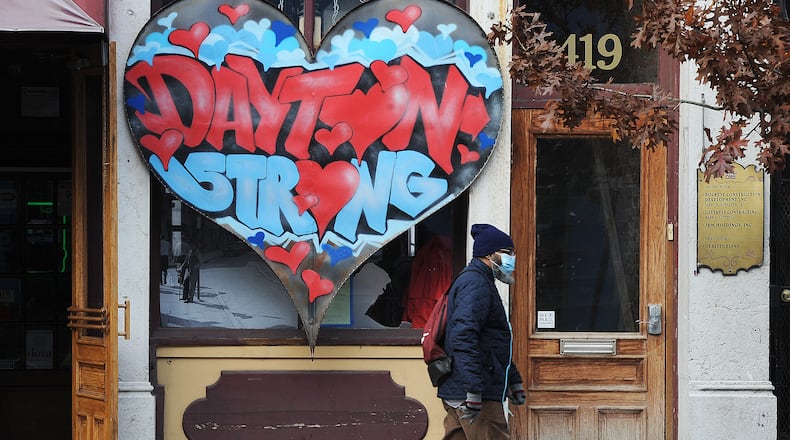“While the investigation uncovered the attacker had a history of mental illness, as well as suicidal and violent fantasies, there were no specific warnings he intended to commit a crime,” the FBI said in a report. “There was also no indication that the attacker discussed his intentions to conduct a violent attack with friends or family.”
Credit: DaytonDailyNews
Betts fired into a crowd of people at around 1 a.m. near Ned Peppers Bar and Blind Bob’s on Fifth Street in the Oregon District. Dayton police officers in the area returned fire and killed Betts about 30 seconds after he opened fire.
Those killed in the shooting were Monica Brickhouse, 39; Nicholas Cumer, 25; Megan Betts, 22; Derrick Fudge, 57; Thomas McNichols, 25; Lois Oglesby, 27; Saheed Saleh, 38; Logan Turner, 30; and Beatrice Warren Curtis, 36.
More than two dozen people were injured.
The FBI’s Behavioral Analysis Unit studied evidence to try to find out Connor Betts’ motivation for the shooting. The unit said that Betts’ enduring fascination with mass violence and an inability to cope with a “convergence of personal factors, to include a decade-long struggle with multiple mental health stressors and the successive loss of significant stabilizing anchors experienced prior to August 4, 2019, likely were the primary contributors to the timing and finality of his decision to commit a mass shooting in Dayton, Ohio.”
Todd Lindgren, spokesman with the FBI’s Cincinnati Field Office, told the Dayton Daily News on Monday that Betts was kicked out of his band and broke up with a girlfriend before the shooting. Betts dated a female classmate from a local college starting at least in March 2019, but they broke up in May, according to an application for a federal search warrant.
The girlfriend told the FBI that Betts was previously addicted to methamphetamine but he quit cold turkey while on vacation with his family.
A friend of Betts who was wounded at the scene of the shooting told federal investigators that Betts had relapsed with cocaine in late July, and it was “not interacting well,” the search warrant states.
On Aug. 2, two days before the shooting, Betts told a former co-worker that he had just taken Xanax. After Betts was shot and killed, authorities found a bag of cocaine on his body.
Connor Betts had mental health problems in addition to drug use, Lindgren said, and the FBI also said that Betts fantasized about killing for more than a decade.
“The investigation revealed the attacker fantasized about mass shootings, serial killings, and murder-suicide for at least a decade without sharing specific details with friends or family,” the FBI said. “This underscores the importance of bystanders’ attentiveness to more subtle changes an individual may exhibit that could be indicative of their decision to commit violence, such as a change in personal circumstances, an increase in perceived stressors, or language indicating they may be contemplating suicide.”
The FBI said the investigation involved more than 125 interviews and over 950 surveillance videos which resulted in about 400 hours of footage. It also included an electronic device analysis, review of social media content and other evidence.
Credit: DaytonDailyNews
Read more about the 9 victims:
• Megan Betts
• Monica Brickhouse
• Nicholas Cumer
• Derrick Fudge
• Thomas McNichols
• Lois Oglesby
• Saeed Saleh
• Logan Turner
• Beatrice ‘Nicole’ Warren-Curtis
“Finding answers for the victims and their families has been a driving motivator each day,” FBI Cincinnati Special Agent in Charge J. William Rivers said in the FBI statement. “From the start, this has been a thorough and deliberate investigation. Due to technical challenges accessing lawfully acquired evidence that was encrypted, this investigation has taken significantly longer than expected. However, we are confident that it has uncovered the key facts and that we have done everything in our ability to provide answers to all those impacted by this horrible attack.”
Mental health, “bystander fatigue”
Dion Green, who was with his late father, Derrick Fudge, at the time of the shooting, told the newspaper Monday that he wants to see more specifics about what led to the mass shooting.
“The only thing that’s closed is the case, the families don’t have any closure,” said Green, whose father died in his arms.
The FBI said that interviews with Betts’ friends suggest that “bystander fatigue” may have been a factor in why Betts was not reported to law enforcement before the shooting. The FBI said bystander fatigue is when a person’s concerning behaviors are not reported to authorities by people close to them due to prolonged exposure to the person’s erratic or troubling behavior.
Green said he doesn’t understand how someone who fantasized about killing for so long didn’t raise red flags to those around him.
LaSandra James, the mother of victim Lois Oglesby, said Betts got exactly what he wanted and what he fantasized about for years.
She said so many lives have been “turned upside down” for no obvious reason, and only the shooter truly knows why he did this. She said she wishes Betts was still alive to see all the suffering he’s caused.
James said closure is a complicated process, adding, “the key for me is learning to live with what happened.”
Victims, others respond
Cody Wolfe, who ran by the Oregon District gunman to help a woman who was shot in the head during the massacre, said the conclusion of the investigation provides some closure but it’s very important that the community not forget what happened.
He said this tragedy shows that evil exists in the world, but it also highlights the importance of paying attention to others and ensuring people who need help get it.
“This is something the community honestly can learn from, in the sense that we need to always check on each other,” he said. “Obviously we need to take mental health seriously.”
Wolfe, a 28-year-old veteran of the Marine Corps, said he hopes people will be on the lookout for warning signs of violence and problem behaviors, without being overly suspicious of friends and neighbors.
He said he’s lost friends to suicide, and there were warning signs in some cases, but none in others.
Donna Johnson, the aunt of Thomas “TeeJay” McNichols, said she hopes that the case closing allows everyone impacted to continue healing.
“The families will never get over it; we still have our moments too,” she said.
When to speak up
Members of the public should report people who show interest in mass killings and suicide, Lindgren said.
“The goal obviously is to prevent any kind of violent behavior,” he said. “That may include reporting issues to family members, clergy or mental health experts or law enforcement.”
Lindgren said reporting concerns to authorities could help prevent another tragedy.
“We all have a responsibility, I think, to speak up when something is not right — and those closest to an individual know that best,” he said.
The FBI investigation took time partly because they recovered a device with encryption protection that meant its contents could not be accessed through normal methods, Lindgren said.
The FBI thought it was important to review its contents to determine if there were any materials related to the attack, but accessing that data took much longer than anticipated, he said.
Lindgren declined to identify what device he was referencing, but federal search warrants show authorities seized phones, laptops and other computer hardware from Betts’ Bellbrook home. One computer belonged to his father. Attempts to reach Betts’ parents for comment for this story were unsuccessful.
Dayton Interim Police Chief Matt Carper said in a statement that the shooting was senseless and unnecessary.
“These victims and their families will forever be in our thoughts and prayers,” Carper said. “I would like to personally thank the officers who took immediate action to stop the violence, undoubtedly preventing further injury and loss of life on a scale that is tough to consider. We also commend the amazing work of the responding officers who walked into unknown danger to transport the wounded, comfort the frightened, and secure a massive crime scene for the important investigation that would follow.
“We are grateful to the numerous local, state, and federal agencies, both law enforcement and victim services-related, that answered the call and helped during our time of need,” Carper added. “We are thankful for our resilient community, which stepped up and offered to help in the healing process in whatever ways they were able. This city will not be defined by one horrible event, instead we were able to define what it means to come together and be Dayton Strong.”
Key findings
** Betts was not aligned to any specific ideological group
** Betts fantasized about mass shootings for a decade
** He gave no specific warning that he intended to commit a crime
** The “primary contributors” to his attack were a fascination with mass violence, mental health struggles and the loss of “stabilizing anchors” in his life.
Source: FBI and Dayton Police report


